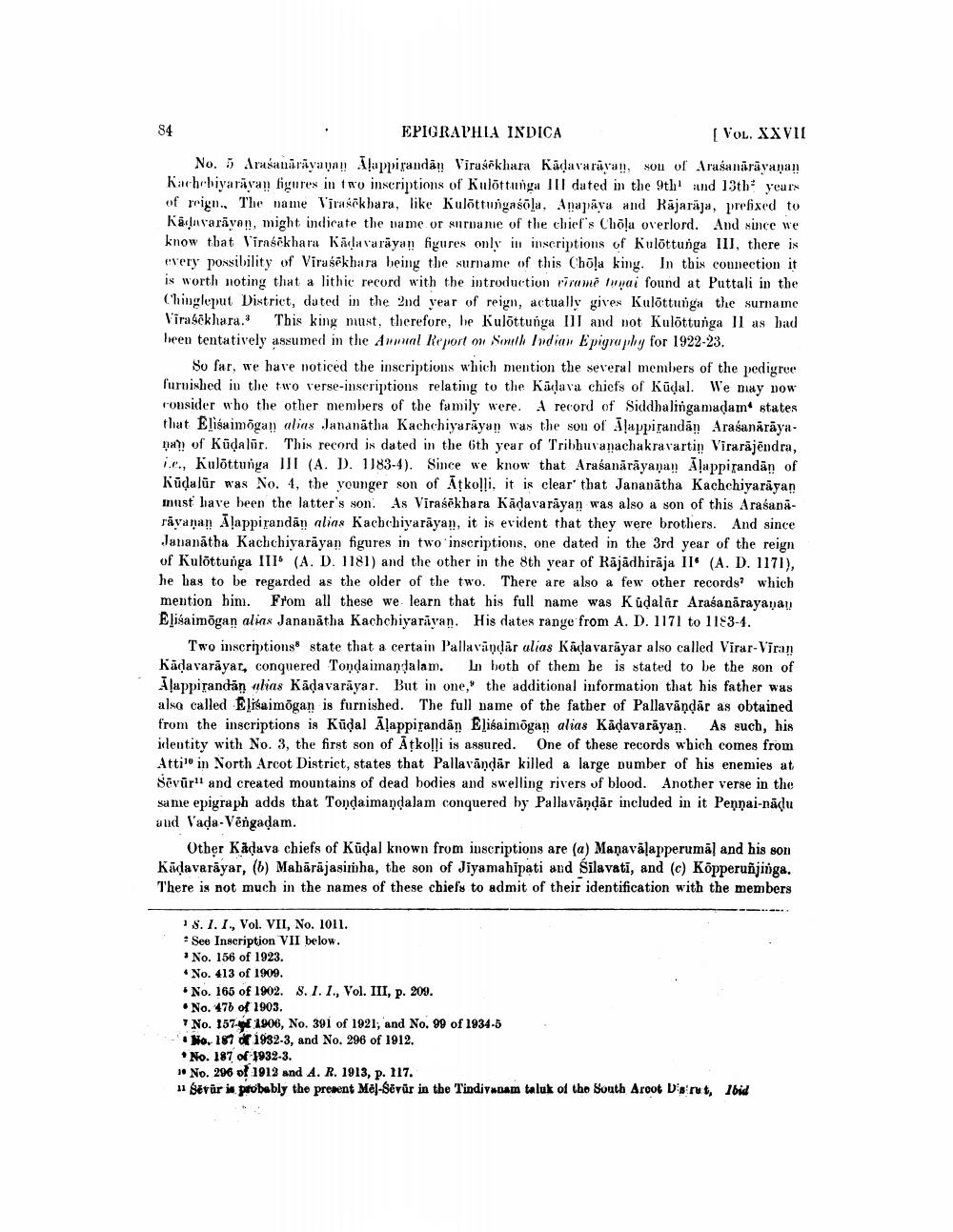________________
EPIGRAPHIA INDICA
[Vol. XXVII No. 5 Arašanārāyaman Alappirandān Virasēkhara Kādavaravan, son of Arusanārāyanan Kachchiyarāvan figures in two inscriptions of Kulõttunga lll dated in the 9th und 13th year's of rign. The name Virasökbara, like Kulõttunyaśāla. Amapáva and Rajaraja, prefixed to kādu varāvan, might indicate the name or surname of the chief's Chöļa overlord. And since we know tbat Virasēkhara Kaclavarayan figures only in inscriptions of Kulottunga Ill, there is every possibility of Virusekbara being the surname of this Chöļa king. In this connection it is worth noting that a lithic record with the introduction virame tupai found at Puttali in the (hingloput District, duted in the 2nd year of reign, actually gives Kulottunga the surname Virasekhara. This king must, therefore, be kulõttunya III and not Kulottunga ll as bad been tentatively assumed in the Annual Report ou South Indian Epigraphy for 1922-23.
So far, we have noticed the inscriptions which mention the several members of the pedigree furnished in the two verse-inscriptions relating to the Kādava chiefs of Kūdal. We may pow consider who the other members of the family were. A record of Siddhalingamadamo states that Elisaimõgan alias Jananātha Kachchiyarāyan was the sou of Ilaypirandan Arašanārāyanan of Kudalur. This record in dated in the 6th year of Tribhuvanachakravartin Virarājēndra, ic., Kulottunga III (A.D. 1183-4). Since we know that Arašanārāyanan Alappirandän of Kūdalūr was No. 4, the younger son of Atkolli, it is clear that Jananātha Kachchiyarāyan must have been the latter's son. As Virasekhara Kādavarāyan was also a son of this Araśanarāvanan Alappirandān alias Kachchiyarāyan, it is evident that they were brothers. And since Jananātha Kachchiyarāyan figures in two inscriptions, one dated in the 3rd year of the reign of Kulõttunga III (A. D. 1181) and the other in the 8th year of Rajadhirāja II. (A.D. 1171), he has to be regarded as the older of the two. There are also a few other records? which mention him. From all these we learn that his full name was Kudalar Arasanarayanan Elisaimõgan alias Jananātha Kachchiyarāvan. His dates range from A. D. 1171 to 1183-4.
Two inscriptions state that a certain Pallavandär alias Kādavarāyar also called Virar-Viran Kādavarāyat, conquered Tondaimandalam. In both of them he is stated to be the son of Alappirandān alias Kādavarāyar. But in one, the additional information that his father was also called Elisaimõgan is furnished. The full name of the father of Pallavāņdār as obtained from the inscriptions is Kūdal Alappirandān Elisaimõgan alias Kādavarāyan. As such, his identity with No. 3, the first son of Ātkolli is assured. One of these records which comes from Atti in North Arcot District, states that Pallavāndar killed a large number of his enemies at Sēvürl and created mountains of dead bodies and swelling rivers of blood. Another verse in the same epigraph adds that Tondaimandalam conquered by Pallavändār included in it Pennai-nadu and Vada-Vengadam.
Other Kådava chiefs of Kudal known from inscriptions are (a) Manavālapperumal and his son Kādavarāyar, (b) Mahārājasimha, the son of Jiyamahipati and Silavatī, and (c) Köpperuñjinga. There is not much in the names of these chiefs to admit of their identification with the members
18.1. I., Vol. VII, No. 1011. - See Inscription VII below. * No. 156 of 1923. • No. 413 of 1909.
No. 165 of 1902. 8. 1. 1., Vol. III, p. 209. .No. 476 of 1903. No. 157- 1906, No. 391 of 1921, and No. 99 of 1934-5
No. 181 1982-3, and No. 296 of 1912. * No. 187 of 1932-3. * No. 296 of 1912 and A. R. 1913, p. 117. 11 gëvür i probably the prevent Mēj-Sevür in the Tindiv.nam taluk of the South Aroot Disnut, Ibid




